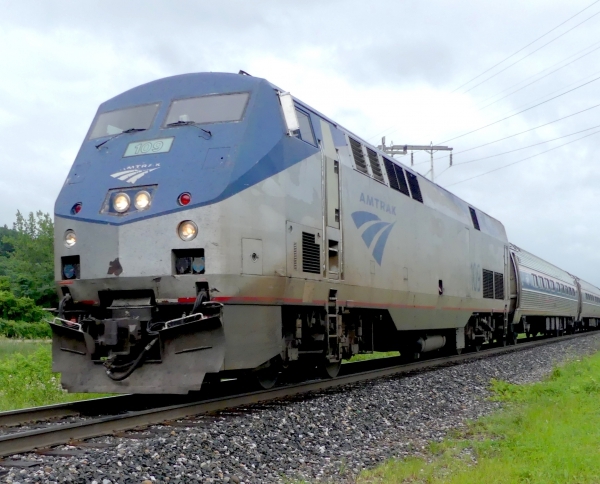BRATTLEBORO — Windham County's only daily passenger train, Amtrak's Vermonter, has not stopped in Brattleboro or Bellows Falls since March 26, due to the COVID-19 pandemic.
And it may be weeks, if not months, before the train returns to the rails of Vermont.
Neither Amtrak nor the Vermont Agency of Transportation (AOT), the primary funder of the Vermonter, has given a specific date for the resumption of service of the daily train between St. Albans and Washington, D.C.
Amtrak cut back the northbound starting point of the Vermonter to New Haven, Conn., in late March.
According to Vermont Business Magazine, Dan Delabruere, the AOT's Rail and Aviation Bureau director, wrote in mid-August that “the state is watching the COVID-19 numbers and evaluating the data not only in our state but also [in places] where the trains travel from.”
“We are hoping to resume service when the numbers can safely support the train returning to Vermont,” he told VBM.
However, rail advocates counter that those statistics support a return of the Vermonter and the Ethan Allen Express, the daily New York City to Rutland train that also saw its route truncated, to Albany, N.Y., on March 26.
The Rutland-based Vermont Rail Action Network (VRAN) held an online meeting on Aug. 26 to discuss the future of rail travel in Vermont in the wake of COVID-19. Nearly 40 people took part in the 75-minute afternoon meeting.
VRAN Executive Director Christopher Parker said that money in the state's fiscal year 2021 budget is available to operate both trains.
“Rail service is fully funded for FY21,” Parker said. “In theory, the plan is to continue to run the trains.”
Parker said there was a chance that service could resume as soon as October, but there have been no signs of movement by the state or Amtrak.
VRAN board member Brad Worthen charged Gov. Phil Scott and his administration with “not making it a priority to restart service. It's not an issue with Amtrak.”
Carl Fowler, a VRAN board member who also has a seat on the Vermont Rail Advisory Council, said that council members have been “trying to get the state to clearly articulate when it would restart service,” as well as laying out what specific COVID-19 reopening criteria need to be achieved.
Riding the rails safely
Fowler said that while passenger service has resumed at Burlington International Airport, as well as interstate bus travel from Vermont to points south, rail service remains in limbo.
Parker said other states have successfully resumed their interstate passenger rail service, including the Downeaster, the Amtrak service between Portland, Maine and Boston that is subsidized by both Maine and Massachusetts.
COVID-19 concerns shut down the Downeaster in March, but Parker said service resumed on June 15, starting with one roundtrip train a day rather than the usual five daily trains.
Ridership was about 100 passengers a day, he reported - a far cry from the train service's average daily ridership of 1,700 to 1,800 last year.
On July 20, the schedule was expanded to four daily trains, and ridership went up to 200 per day. All this occurred, Parker said, with no marketing at all by Amtrak or the state of Maine.
Like Vermont, tourism is a big part of the Maine economy, accounting for 1 in 6 jobs in Maine. Reports estimate that Maine's tourism economy has lost 90 percent of its business this summer due to COVID-19, but Parker said Maine officials hope that the return of rail service will provide a boost.
The Downeaster was also popular with commuters to Boston from the seacoast towns in Maine and New Hampshire, but Parker said nearly all of that ridership has vanished with the pandemic.
Parker said Amtrak has gone out of its way to clean its trains and upgrade ventilation systems in the rail cars. Amtrak has capped capacity on its trains to 50 percent and requires everyone to wear a mask when riding.
What's next?
The Vermont Rail Advisory Council hasn't met since December. Its March meeting was canceled due to the pandemic.
The council plans to meet online on Wednesday, Sept. 9, and Fowler said resumption of passenger rail service will be at the top of the agenda.
But he added that it will take public pressure on the AOT and the Scott administration to get them to move forward.
The next complication might be Amtrak, which has proposed cutting schedules on its long-distance trains to three days per week, citing lower ridership.
But Fowler said if the Vermonter were to do so, it would “completely destroy in-state ridership.”
Currently, the closest rail option open to southern Vermont travelers is the Valley Flyer, a passenger train subsidized by Massachusetts and Connecticut that is currently running once a day between Greenfield, Mass., and New Haven, Conn., with connections to Amtrak and Metro North trains to New York City.
Weekday southbound trains leave Greenfield at 7:35 a.m. and arrive in New Haven at 10:18 a.m., while weekend trains depart at 9:15 a.m. and arrive in New Haven at 11:56 a.m.
Weekday northbound trains leave New Haven at 7:35 p.m. and arrive in Greenfield at 10:23 p.m., while weekend trains leave New Haven at 5 p.m. and arrive in Greenfield at 7:53 p.m.
A second weekend train leaves Greenfield at 8:10 p.m. and arrives in Springfield at 9:18 p.m. to connect to a CTRail shuttle train that arrives in New Haven at 11:18 p.m.
